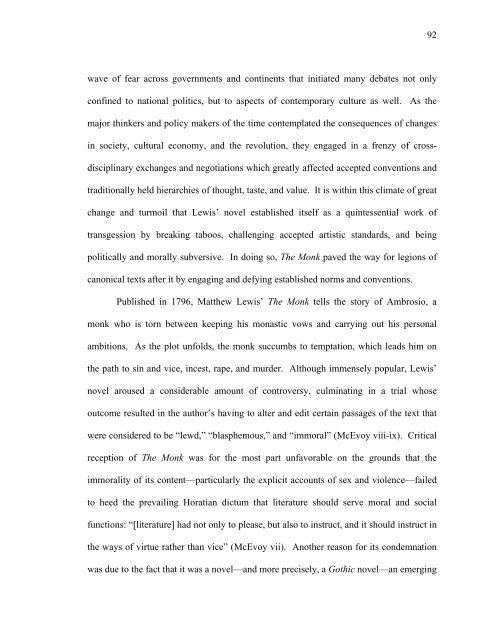Untitled - Sexey's School Moodle
Untitled - Sexey's School Moodle
Untitled - Sexey's School Moodle
You also want an ePaper? Increase the reach of your titles
YUMPU automatically turns print PDFs into web optimized ePapers that Google loves.
wave of fear across governments and continents that initiated many debates not only<br />
confined to national politics, but to aspects of contemporary culture as well. As the<br />
major thinkers and policy makers of the time contemplated the consequences of changes<br />
in society, cultural economy, and the revolution, they engaged in a frenzy of cross-<br />
disciplinary exchanges and negotiations which greatly affected accepted conventions and<br />
traditionally held hierarchies of thought, taste, and value. It is within this climate of great<br />
change and turmoil that Lewis’ novel established itself as a quintessential work of<br />
transgession by breaking taboos, challenging accepted artistic standards, and being<br />
politically and morally subversive. In doing so, The Monk paved the way for legions of<br />
canonical texts after it by engaging and defying established norms and conventions.<br />
Published in 1796, Matthew Lewis’ The Monk tells the story of Ambrosio, a<br />
monk who is torn between keeping his monastic vows and carrying out his personal<br />
ambitions. As the plot unfolds, the monk succumbs to temptation, which leads him on<br />
the path to sin and vice, incest, rape, and murder. Although immensely popular, Lewis’<br />
novel aroused a considerable amount of controversy, culminating in a trial whose<br />
outcome resulted in the author’s having to alter and edit certain passages of the text that<br />
were considered to be “lewd,” “blasphemous,” and “immoral” (McEvoy viii-ix). Critical<br />
reception of The Monk was for the most part unfavorable on the grounds that the<br />
immorality of its content—particularly the explicit accounts of sex and violence—failed<br />
to heed the prevailing Horatian dictum that literature should serve moral and social<br />
functions: “[literature] had not only to please, but also to instruct, and it should instruct in<br />
the ways of virtue rather than vice” (McEvoy vii). Another reason for its condemnation<br />
was due to the fact that it was a novel—and more precisely, a Gothic novel—an emerging<br />
92



